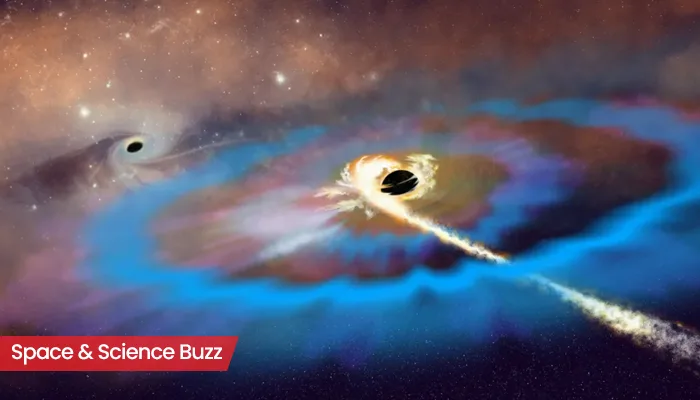Successful Launch, Reaching Record Height to Spacewalk on Sept 12: How Polaris Dawn Stands Out in Space History
- Soham Halder
- 1 year ago
- 4 minutes read

SpaceX's Polaris Dawn has blasted out of the atmosphere carrying four astronauts as part of a privately funded mission to carry out the first-ever commercial spacewalk.
Welcome to a brand new era of space exploration with the Polaris Dawn mission. Along with billionaire Jared Isaacman, other crew members participating in this mission are Anna Menon, Scott Poteet, and Sarah Gillis. The daring trek into Earth orbit will include passing through the inner Van Allen radiation belt, “one of two donut-shaped swaths of highly energetic particles from the sun that are magnetically trapped around Earth,” according to SpaceX. This mission will be written in the history book of space exploration for many reasons. Let's find out why.
— SpaceX (@SpaceX) September 11, 2024
(Credit - @SpaceX X handle)
Reaching Maximum Height:
The company confirmed that the spacecraft has already reached its peak altitude of 1,400.7 kilometers or 870 miles, surpassing NASA’s 1966 Gemini 11 mission’s record. The mission reached a height of 853 miles or 1,373 kilometers during its trek.
Through the Polaris Dawn mission, humans have reached the farthest location journeyed since Apollo mission in 1972. This is also the farthest point a woman has ever reached.
First-ever Private Spacewalk:
Till now, only funded government agencies have conducted spacewalks or extravehicular activities (EVAs). This is the first time when a private firm has dared to do something like that. Thus, SpaceX owner Elon Musk recently hailed this upcoming Polaris Dawn mission as “epic”.
Polaris Dawn and Dragon at 1,400 km above Earth – the farthest humans have traveled since the Apollo program over 50 years ago pic.twitter.com/rRDeD1dY1e
— SpaceX (@SpaceX) September 11, 2024
(Credit - @SpaceX X handle)
Only two crew members Jared Isaacman and Sarah Gillis, the lead space operations engineer at SpaceX will be participating in this revolutionary spacewalk.
The groundbreaking will be conducted September 12 for two hours while orbiting at 435 miles or 700 kilometers above the Earth.
“Crew safety is absolutely paramount and this mission carries more risk than usual as it will be the furthest humans have travelled from Earth since Apollo, and the first commercial spacewalk,” Musk wrote on social media platform, X.

(Credit - @SpaceX X handle)
Use of State-of-the-art Spacesuits:
The astronauts are using SpaceX’s new EVA suits, designed for a “pre-breathe” process to prepare them for the spacewalk.
“It works by slowly purging nitrogen from the crew members’ blood so that the gas does not bubble up in their bloodstream as the pressure changes inside the vehicle,” mentioned by SpaceX during demonstration. This strategy is adopted to avoid decompression sickness, often faced by scuba divers.
“What is really cool about this (pre-breathing) profile is it actually, in many ways, is much less risky than what the standard is on the space station. It’s like opening a can of soda pop — and you want to open the can (and have) none of the bubbles to come out because the pressure outside of the can is equal to what’s inside,” mentioned Sarah Gillis.
Dragon will initiate a two-day pre-breathe process to prepare the crew for their upcoming spacewalk on Thursday, September 12 pic.twitter.com/xxL2TRV6JX
— SpaceX (@SpaceX) September 10, 2024
(Credit - @SpaceX X handle)
A Mission for Securing Humanity’s Future:
The data collected will be used for analysing human health in space. Human body’s reaction to this extremely low gravity area will be crucial for alternate space habitation. Another important aspect is checking Starlink WiFi for future space mission communication. NASA will analyze Telemedicine facilities after gathering important health data with Polaris Dawn crew.
Growth of Private Space Firms:
From manufacturing to operating satellites and conducting missions, private companies like SpaceX, Blue Origin, Virgin Galactic, Axiom Space have enhanced the access to the space.

(Credit - @PolarisProgram X handle)
The participation of private spaceflight organisations from the middle of 20th and in ongoing 21st century have greatly impacted space exploration as well as commercialization of the space industry. This will surely have a huge impact on future space policies opening the door for public interest and investments.
Successful completion of Polaris Dawn will probably be one of the biggest steps for civilian space travel.

.webp)
.WEBP)
.WEBP)
.webp)
.webp)


.webp)
.webp)
.webp)

